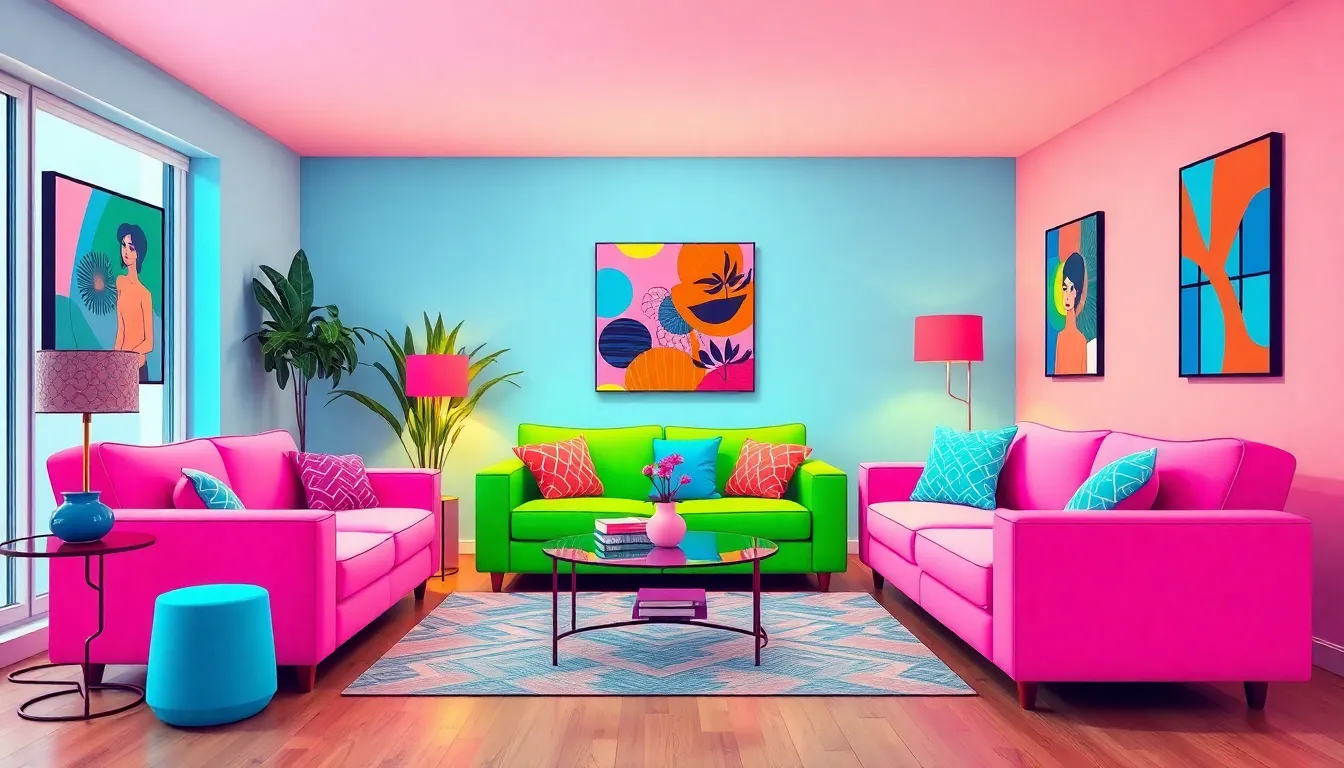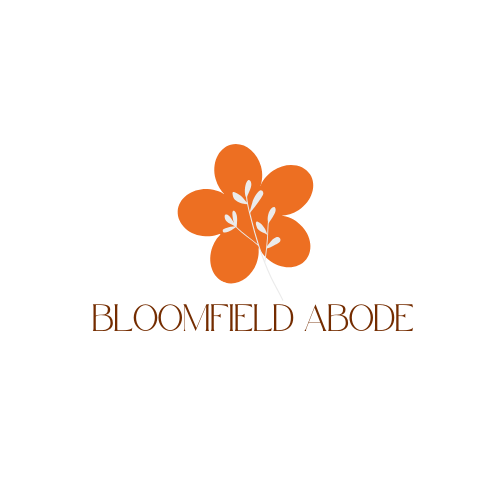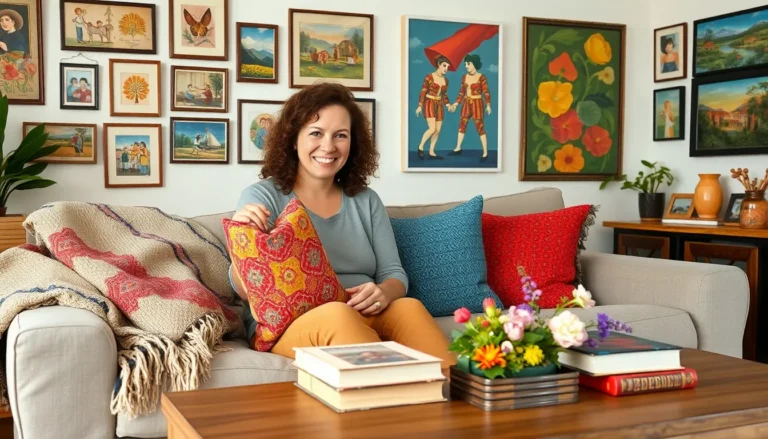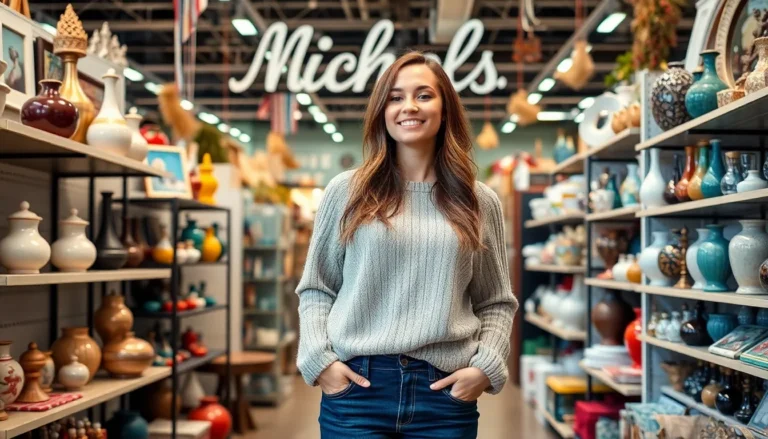Step into a time machine and blast back to the vibrant world of 80s home decor, where neon colors ruled and creativity knew no bounds. Remember the days when every living room boasted a geometric-patterned sofa and a cassette player? If you’re ready to embrace the quirky charm of this unforgettable decade, you’re in for a treat.
80s Home Decor
80s home decor showcased bold colors and eclectic designs that defined the decade. Neon shades like pink, green, and blue flooded living spaces, making rooms vibrant and lively. Geometric patterns frequently appeared on everything from wallpapers to furniture, adding an energetic feel.
Furniture styles embraced comfort and fun with oversized sofas and bean bags dominating family rooms. Many households featured glass and chrome accents, reflecting the era’s futuristic influence.
Art pieces often included abstract wall hangings or large-scale prints, emphasizing a playful aesthetic. Accessories, such as lava lamps and cassette players, became staples in designing distinct interiors.
Textiles played a crucial role as well, with shag rugs and pastel drapes enhancing the inviting atmosphere. Additionally, plants like potted ferns and philodendrons brought a touch of nature indoors, contributing to home warmth.
Lighting trends highlighted bold choices; funky floor lamps and ceiling fixtures added unique flair to each room. Popular options included pendant lights with colorful shades, making them attractive focal points.
Overall, 80s home decor reflected the decade’s spirit, characterized by creativity and self-expression. The combination of vibrant colors, striking patterns, and an eclectic mix of accessories created environments that were as unique as those who lived in them.
Key Features of 80s Home Decor

80s home decor shines with distinctive and playful elements. Unique traits characterize this vibrant era.
Bold Colors and Patterns
Bright neon colors dominated the 1980s aesthetic. Pink, green, and blue brought energy to every room. Walls often showcased striking patterns, creating lively environments. Fabrics featured bold prints, enhancing the whimsical charm. Popular items included patterned upholstery, which made sofas and armchairs stand out. Cushions in clashing colors added an extra layer of excitement. Homeowners embraced the fun of mixing and matching hues and designs. These bold choices reflected the decade’s spirit of creativity and individuality.
Geometric Shapes and Designs
Geometric patterns defined the visual landscape of 80s interiors. Shapes like triangles, squares, and circles appeared in wallpapers and furniture, promoting a modern vibe. Accents often incorporated abstract designs, creating focal points throughout the space. Tables and chairs featured unique forms that deviated from traditional designs. This trend extended to art pieces, many of which depicted dynamic, angular layouts. Diverse layouts in rugs and textiles also contributed to the overall theme. Each element combined to form an eclectic and animated atmosphere.
Popular Materials in the 80s
Materials played a vital role in defining 80s home decor, contributing to its unique and vibrant charm.
Plastic and Vinyl
Plastic and vinyl became staples in 80s interiors, offering versatility and bold colors. Easy to clean and maintain, these materials surfaced on furniture and accessories. Vinyl upholstery adorned everything from chic sofas to playful bean bags, providing a fun and youthful aesthetic. Brightly colored plastic decorations, like geometric planters and quirky wall hangings, added to the energetic vibe. With their lightweight nature, plastic items allowed for easy rearrangements, perfect for accommodating changing tastes. This approach to using plastic and vinyl reflected the decade’s embrace of modernity and creativity.
Wood and Metal Combinations
Wood and metal combinations emerged as a popular choice in the 80s, harmonizing classic warmth with sleek industrial elements. Furniture makers frequently paired medium-toned woods with polished chrome or brass, creating striking visual contrasts. Dining tables featured rich wood surfaces complemented by shiny metal bases, enhancing their appeal. Display cabinets showcased wooden frames accentuated with metal hardware, merging traditional craftsmanship with contemporary design. The blend of these materials produced a sense of balance, resonating with the larger design trends of the time. This fusion encapsulated the transitional spirit that characterized residential spaces during the 80s.
Iconic Furniture Styles
The 1980s showcased dynamic furniture styles that remain memorable. Sectional sofas stood out for their versatility and comfort. They often featured bold fabrics adorned with geometric patterns, creating an eye-catching centerpiece in living rooms. Often designed for large gatherings, these sofas provided ample seating and encouraged social interaction.
Coffee tables with flair also defined the era. Funky designs and unconventional shapes set them apart, often featuring glass or mirrored finishes. Unique materials, such as vibrant plastics and glossy woods, added visual interest. Many coffee tables incorporated storage options, accommodating magazines and remotes, while enhancing functionality. Both furniture types captured the energetic spirit of the decade, crafting lively living spaces.
Accessories That Defined the Decade
Accessories showcased the vibrant culture of the 1980s. Each item reflected the boldness and creativity characterizing the era.
Neon Lights and Signage
Neon lights illuminated homes with a glitzy flair. Bright colors such as hot pink and electric blue dominated these lighting features. They became centerpieces in living rooms and entertainment spaces, adding a dynamic touch. Signs displaying fun phrases or brand logos captured attention. Many homeowners displayed these colorful adornments, reinforcing a lively atmosphere. Neon accents complemented the geometric patterns found in furniture and textiles, creating cohesive designs. These light fixtures played a significant role in setting the mood for social gatherings, enhancing the overall energy of spaces.
Wall Art and Décor Trends
Wall art reflected the expressive spirit of the decade. Large abstract paintings and vibrant prints adorned living areas and dining spaces. Popular trends included the use of posters featuring iconic musicians and movie stars, celebrating pop culture. Brightly colored frames added an extra pop to these pieces, emphasizing the playful aesthetic. Geometric shapes appeared frequently on walls, harmonizing with furniture styles. Many homes featured tapestries and fabric wall hangings, incorporating texture alongside visual stimulation. These art elements combined eclecticism and creativity, making each space authentically representative of 80s style.
Conclusion
The vibrant world of 80s home decor continues to inspire and evoke fond memories. Its bold colors and playful patterns reflect a time when self-expression flourished in every corner of the home. From oversized sofas to funky lighting fixtures, each element tells a story of creativity and individuality.
Reviving these iconic styles can bring a sense of nostalgia and fun to modern interiors. Whether it’s incorporating neon accents or embracing geometric designs, the essence of the 80s remains a timeless source of inspiration. Embracing this aesthetic allows homeowners to create spaces that are not only inviting but also bursting with character.





